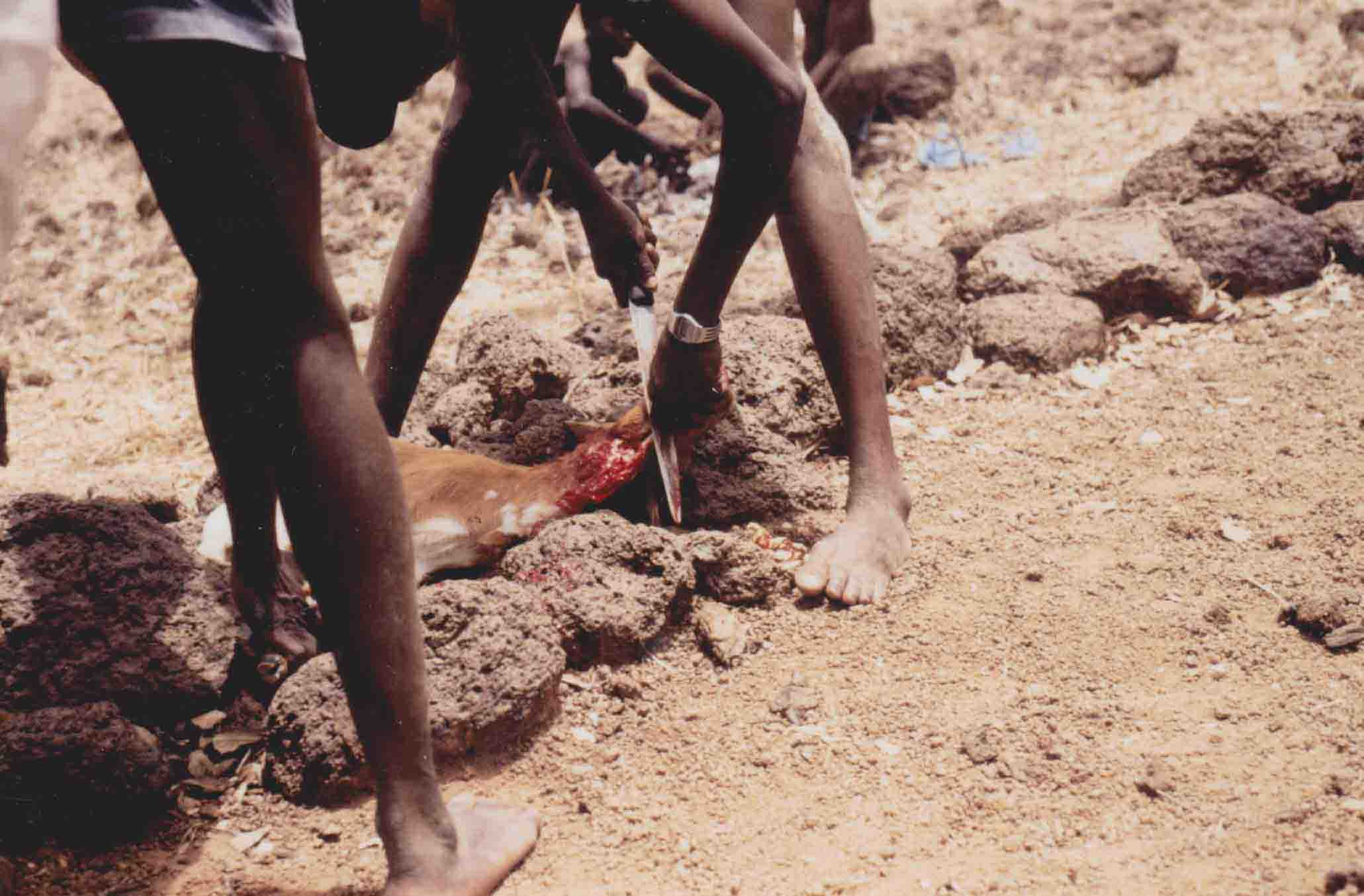
Fig. 1. Outer stone ring of Pung Muning Shrine
Franz Kröger
REVIEW OF THE GUIDEBOOK
Insoll, Timothy, Benjamin Kankpeyeng, Samuel N. Nkumbaan and Malik Saako (2013)
Fragmentary Ancestors. Figurines from Koma Land, Ghana. Manchester (Museum).
It is the sincere wish of the reviewer that the following review
serve as a catalyst for extensive discussions on the function and meaning of the
Komaland terracottas.
1 Stone Rings
The term “stone circle sites” (or “stone ring sites”) has always been closely associated with the old Komaland culture. The name is used, for example, in the titles of Anquandah’s articles from 1986 (“Investigating the Stone Circle Mound Sites...”) and 1987 (“The Stone Circle Sites of Komaland”) as well as in Kankpeyeng’s paper from 2008 (“Rethinking the Stone Circles of Komaland...”).
|
|
|
Fig. 1. Outer stone ring of Pung Muning Shrine |
Circular stone monuments are not rare in West Africa and can be found in Gambia (e.g. Wassu and Kerr Batch), Senegal (e.g. Sine Ngayène and Wanar) and also in Mali. At these sites, the stones reach a height of approximately 1.5 - 2 metres and, in exceptional
|
|
|
Fig. 2. The two stone rings of Pung Muning Shrine |
cases, even 3 metres. However, I have never seen stone circles having this height in the Koma area.
The Guide (p. 9) mentions stone rings or a layer of covering stones featured at some earth mounds. If the stones consist only of rounded laterite blocks, then it is a kind of stone ring not rare in Northern Ghana. Among the Bulsa and other ethnic groups of Northern Ghana (but not among the present Koma), the walls of all important round or square houses are built on a circle or a rectangle of stones.
Stone rings for big earth shrines are very typical and represent the walls of a compound. They possess an entrance gate consisting of one big stone that is opened when people enter the circle after having greeted the shrine spirit outside the spirit’s compound. The stone ring is closed again after the sacrifice. The Pung Muning Earth Shrine in Wiaga-Badomsa even has two stone circles: one for all the visitors of a sacrifice and a smaller one for the shrine and those closely involved in a sacrifice, e.g. a child who is dedicated to the shrine (Fig. 1 and 2).
2 Horse or Camel?
Anquandah and the editors of the Guide suggest that the animals being ridden might be either horses or camels. It is true that many terracotta heads resemble camel heads more than those of horses, but the artist was probably not so much interested in its naturalistic depiction as in its function, namely to receive libations in its wide-open mouth. For this reason the horse’s neck and head had to be raised, and thus it lost its horse-like appearance (cf. also Fig. 62). Most importantly, none of the 42 rider-and-horse figurines with which I am familiar exhibit a hump, the most typical feature of a camel.
On the other hand, the horse-figurines possess all the typical characteristics of a particular horse-breed and its harness. At least two horse traditions left their traces in West African history (cf. Law 1980).
1) A small pony-like breed. It was ridden without a saddle, stirrups and a bit, and it was directed by only a single rein.
2) Beginning in the 13th century, larger horses sporting a bit, a saddle, stirrups and a double rein were introduced into West Africa from the Islamic world.
There is no doubt that all the rider-and-horse terracottas, including the figurine of this exhibition (p. 11), belong to the first type. The rider’s body is nearly the same size as the horse’s, and in some figurines the rider’s feet nearly touch ground. There are no stirrups, saddles and bits, and the horse is directed by a single rein which starts at the nose strap.
|
|
|
Fig. 3 - 8. Applications on the horses' heads |
|
|
|
Fig. 9 - 16. Horses' tails |
Like all other terracotta horses, the exhibited figurine has a small ball-like application between its ears. Its exact function is still unknown, though it may be an amulet containing magical substances. On a Roman stone relief representation of the 1st century AD, a similar object is depicted between the ears of a horse. It is
|
|
|
Fig. 17. "Weapon" |
interpreted as the hairs of the horse’s forehead bound up into a tuft (Junkelmann 1992, p. 76). This interpretation doesn’t seem to be very applicable to the exhibited horse, but it becomes more probable when we include similar but pointed forms on other horses.
Most Komaland horse terracottas have a docked tail represented by a short vertical shape. Only a small number, and among them the exhibited figurine, have a long tail.
Apart from the arm dagger (see below), other weapons were modelled on the terracotta riders, e.g. quivers on their backs (similar to those of the Djenné terracottas depicting riders) and other unidentifiable objects that might be weapons. Also the figurine in the exhibition is wearing an object in his right hand that was probably used as a weapon. It might be another knife, but more probably it may represent a throwing stick/cudgel in wood or metal as they have been employed in other groups of West Africa. Among the present Bulsa, the wooden throwing stick is only used by hunting shepherd boys.
The rider-and-horse figurine of the exhibition is an interesting and beautiful specimen, but does not differ very much from other representations of the same type.
3 Arm Daggers
Four of the exhibited figurines (pp. 14, 16, 28 and an additional photo on p. 13) wear a weapon on the left arm that is cautiously identified by the authors of the Guide as a dagger (p. 10). This caution is probably not necessary since more than 100 figurines (not on display in the exhibition) wear weapons on the upper arm that can be clearly interpreted as daggers. Usually the knife has a curved form that is covered with a sheath, and its blade has been obscured under some forearm bracelets (Fig. 19 - 20).
|
|
|
Fig. 18. Distribution of the arm dagger. X= Komaland12= Salaga (Source: Lagercrantz 1937, p. 426) |
At first glance, the arm dagger, as worn by most Komaland horsemen, looks like an extraordinary and unique weapon, but its existence does not give us any clue about who the creators of the terracottas were or where they came from. A distribution map (Sture Lagercrantz 1937, p. 426 and 1950, p. 214)
|
|
|
Fig. 19 - 20 Arm daggers |
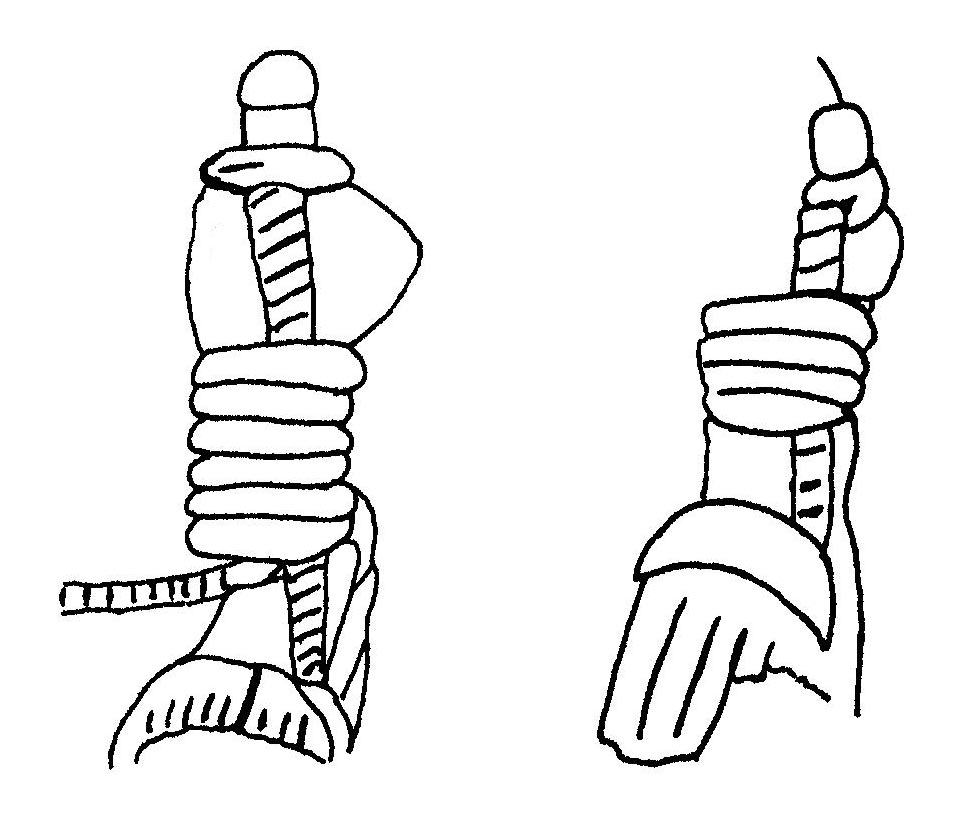 Fig. 21 - 22 Long object under the bracelets
|
shows that the arm-dagger is widely distributed over nearly all parts of West Africa and thus unsuitable as evidence about its origin.
Apart from the arm daggers shaped like curved knives, another unidentified object may be worn under the bracelets of the rider’s left forearm, its tip touching or being inserted under the wrist bracelets (Fig. 21-22). It is doubtful whether this long and perhaps flexible object with a circular cross-section can be classified as another type of knife or whether it might possibly be a riding-whip. In the Guide’s photo (p. 16, top left), it is unclear whether the depicted object belongs to this second type of arm weapon.
4 Wings and Witches
On page 15 (centre right) of the Guide, a small figure is interpreted as follows: “It is possibly a
bird or a winged human” and “ ...the ridge between the eyes is alternatively a nose or possibly
part of a beak similar to that of the hornbill ...”
According to the interpretation of the reviewer, this figure and the one shown on page 22
(right top) can be classified as belonging to a particular type that always has a conical plug as
its lower part (Fig. 23-28). This conical part is probably used for inserting the figure into the ground. The
(always) legless trunk is flattened and widened and usually has, as in the illustration on page
22, incised lines forming various patterns. Such figures were offered sacrifices in their wide-open mouths, and the skulls never have hollows.
|
|
|
Fig. 23 - 28. Coned figurines with flattened trunk |
It must be admitted that the specimens published in the Guide (p. 15 and 22) can easily be interpreted as winged figurines, their conical plugs regarded as the tail feathers. However, one should interpret the figures in the context of other examples of this type because it is assumed that all of these anthropomorphic representations had the same function and meaning. Most of the other specimens of this type do not resemble birds, and thus this excludes any associations with witches.
On page 35 (top) a figurine of a completely different type, its "arms" shortened to stumps, may possibly represent a winged creature, although there are no other facts to support this assertion.
5 Nose and Mouth
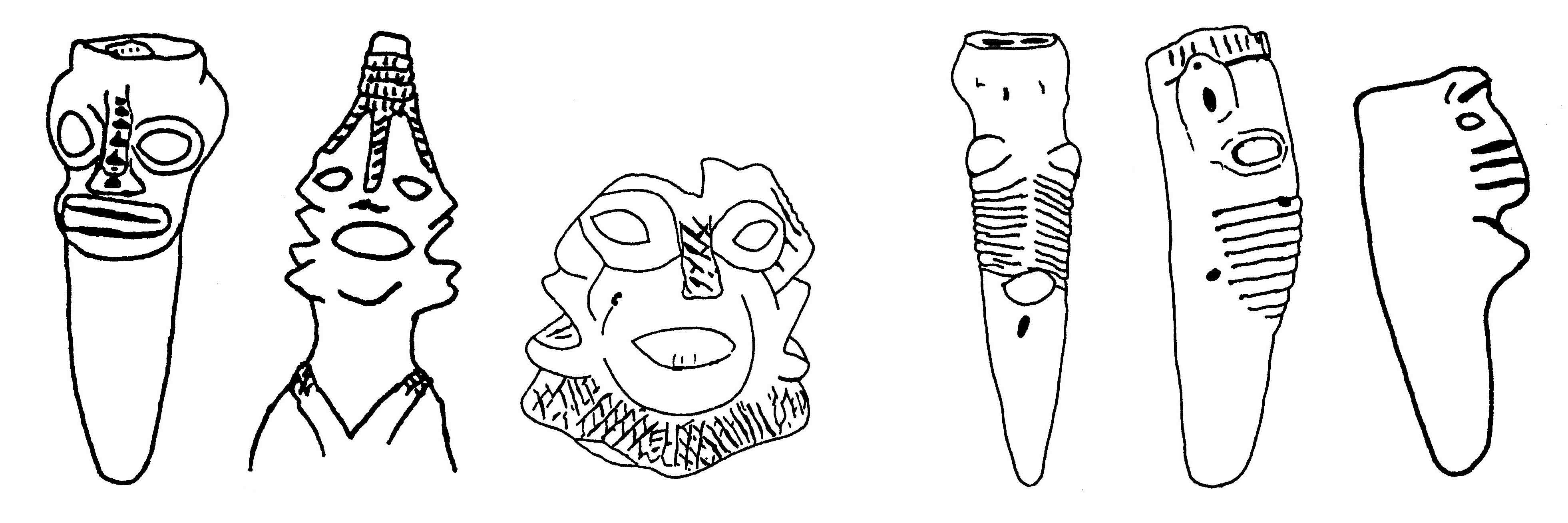 |
|
Fig. 29 - 31. Covered nose Fig. 32 - 34. "Bound mouth" |
On page 17 (bottom right) of the Guide, the authors remark on an elongated anthropomorphic head: "...the incisions on the bridge of the nose are unusual..." However, to my knowledge, similar incisions on the bridge of the nose are not quite uncommon among Komaland figurines (Fig. 29-31), and even in the Guide, there is another example on p. 21 (right, middle).
From other, less damaged figures we can conclude that it probably indicates a tuft of (plaited or unplaited) hair reaching from the main hairdress to the tip of the nose. This hair-style has been worn in more recent times among other ethnic groups, as wooden Mossi/Kurumba dolls prove (cf. also Frehn/Krings 1986, p. 41 and 43).
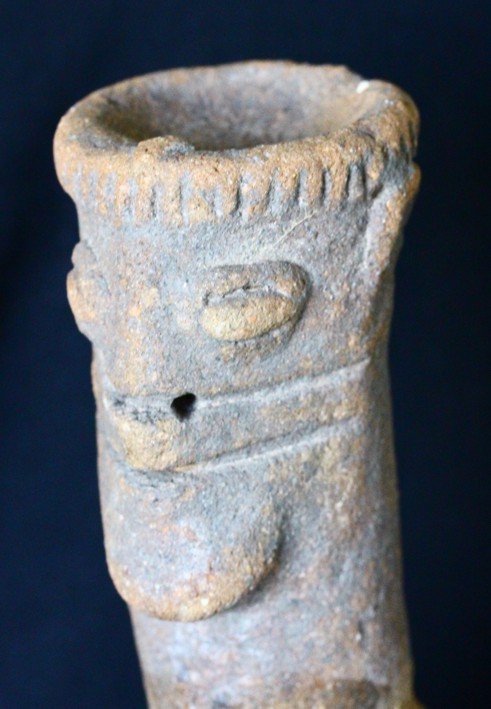 |
|
Fig. 35 |
For the "representation of the bound mouth" (p. 17) on the same figure (six coils of clay wrapped around the mouth area), the reviewer, concurring with the editors, can only speculate that it means a person should be prevented from speaking. Similar representations in other Komaland terracottas are quite rare (Fig. 32-34), but there are also figurines in which one or two deep incisions extends from each corner of the mouth in the direction of the ears (Fig. 35).
In order to interpret the figures as representations of a prisoner or slave, it should be proved
that such methods were used at some point to prevent prisoners or slaves from speaking.
6 The Creators of the Terracottas and Parallels to Other Ethnic Groups
|
|
|
Fig. 36. Wooden head of the Lobi |
It would be helpful to the interpretation of the terracotta figurines if we could find similar figurines in the close vicinity of the excavation area. In reference to northern Ghana, the authors of the Guide point out that "... figurines are no longer made or used, except among the Lobi ethno-linguistic group" (p. 19). This statement, however, is not accurate because even the present Koma people produce anthropomorphic, unfired clay figurines (cf. hunting shrine in Nangruma; in: Kröger / Baluri 2010 , p. 216). Among the Bulsa, free-standing clay sculptures are rare, and they usually depict animals as part of a bush spirit shrine (jadok). More often, however, they produce relief sculptures on walls and barns and make sacrifices to these sculptures (cf. Kröger 2002, pp. 43-44, Appendix Fig. 12-13).
It is true that in recent times only few ethnic groups in northern Ghana have produced figures in clay or wood. The Moba, living partly in Togo, carve wooden figures which are much appreciated on the modern art market. Furthermore, the Dagara offer sacrifices to anthropomorphic wooden ancestor statues (Goody 1962, after p. 100, Fig. 13).
More worthwhile is a comparison of the Komaland terracottas with the figures of the Lobi ethno-linguistic group in Burkina Faso. Although Lobi figures are made of wood, they also feature the typical conical base that allows them to be permanently inserted into clay shrines where they will receive their sacrifices (Fig. 36 and Meyer 1981, p. 35).
7 Double Cones
A particular type of figure consisting of two adjacent and interconnected clay cones, each of which has a sacrificial bowl on top, and a kind of tongue and a deep hole in the centre of the bowl, has led experts to discuss multiple interpretations.
|
|
|
Fig. 37 - 39. Double cones |
In his 1998 publication (p. 150) Anquandah presents photos of four terracottas of the type discussed here. He rejects the interpretation made by other archaeologists that these objects depict metallurgical bellows. Instead he surmises that they represent double bells (cf. Kröger 2002, p. 55). In two other photos of his book (p. 94), the double cones can be seen in front of “females engaged in grinding activities”. Indeed, the bowls of the cones are reminiscent of the querns and the “tongues” are reminiscent of the upper grinding stones, though this is only evident in the published photos; in other figurines such a similarity is not readily clear (40-50).
|
|
|
Fig. 40 - 50. Double Cones |
I was also given the suggestion that the two cones depict a double drum. In Northern Ghana drums are usually played by men, whereas women beat them only on ritual occasions (e.g. at funerals). Double drums are generally beaten with curved sticks that cannot be seen in any photos.
The Guide (p. 23, left centre) resumes the interpretation of the double cones as representing an iron gong (or, more correctly, an "iron double bell"), an instrument that is widespread in Northern Ghana. If we assume that the cone-shaped lower parts of these objects were inserted half-way into either the ground or a clay shrine, as it was probably done with other coned figures, these objects would lose any similarity they have to a double bell in this position.
The main function of the double cone was probably the same as that of the other conical figures: namely, to receive libations in their upper bowls (as indicated in the text of the Guide as a further possible function).
8 The Depiction of Genitals
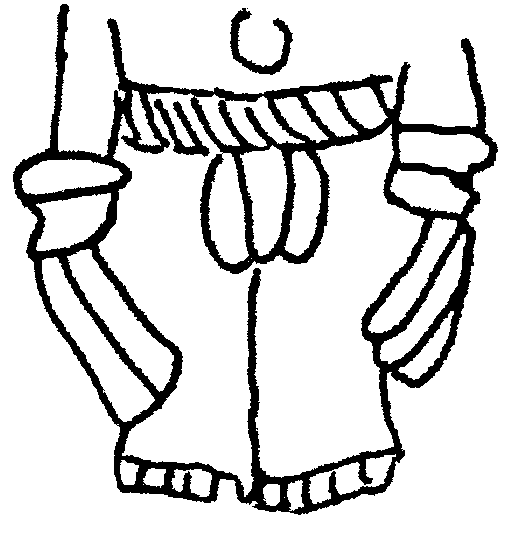 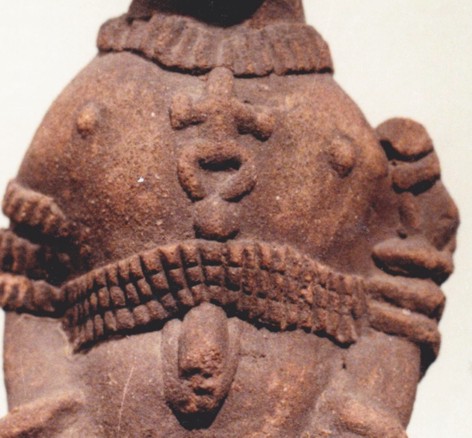 |
|
Fig. 51 - 52. Male genitals |
On page 31 of the Guide, it is noted that “male genitals are not realistically modelled at Yikpabongo”. Although we do not know whether the modelling of male genitals was different in various Komaland settlements, some general remarks about the representation of genitals might be appropriate. According to this reviewer’s knowledge, male genitals are usually depicted very realistically while female genitals, except for those of “mothers”, are generally covered by a square pubic apron. In the mother-and-child representations the woman is stark naked and displays a wide-open vagina.
Perhaps it is not quite correct to say that male genitals are always completely uncovered. On some figurines the tip of the penis has apparently been hidden under the waistband (Fig. 51-52), as is shown in two pictures representing two Lobi men from Northern Ghana found in Rattray’s book (1932, after p. 446, Fig. 115-116).
The “waist belt and modesty apron” (cf. Guide, p. 35, top), which took the form of leaves (in front) and triangle shaped fibre bundles (behind), was quite common among Bulsa women until the 1970s when after a successful anti-nudity campaign they were given up in public life (e.g. for market visits). After that they were only rarely worn within the compound and at particular funeral rituals, when wearing “leaves” is obligatory for the widows of the deceased.
9 Hair or Clothes?
Since the Komaland figurines consist only of terracotta (‘fired earth’), all features of the original models, e.g. those composed of metal, wood, fibres, human flesh and hair, are only represented in clay. This makes it difficult for the analyst to draw any convincing conclusions regarding the original materials. Particular problems arise in determining the real-world materials that might have comprised things like hairdresses, caps, hats, beards and scars.
|
|
|
Fig. 53 - 55. Cylindrical object on the crown of the head |
A very common head- or hairdress found on the figurines consists of a small cylindrical object on the crown of the head (Fig. 53-55). I agree with the PDF-edition of the Guide (p. 29) in which the authors render the following interpretation about a small human head: “The head is shaved except for a patch of hair on the crown...”
It is questionable whether the similar cylindrical application on a head depicted on page 29 (bottom left) should also be regarded as a patch of hair or as part of a cap. The knotted or plaited strains might consist of plaited hair, and this becomes more probable when we regard other specimens having similar hairdresses (Fig. 58-61).
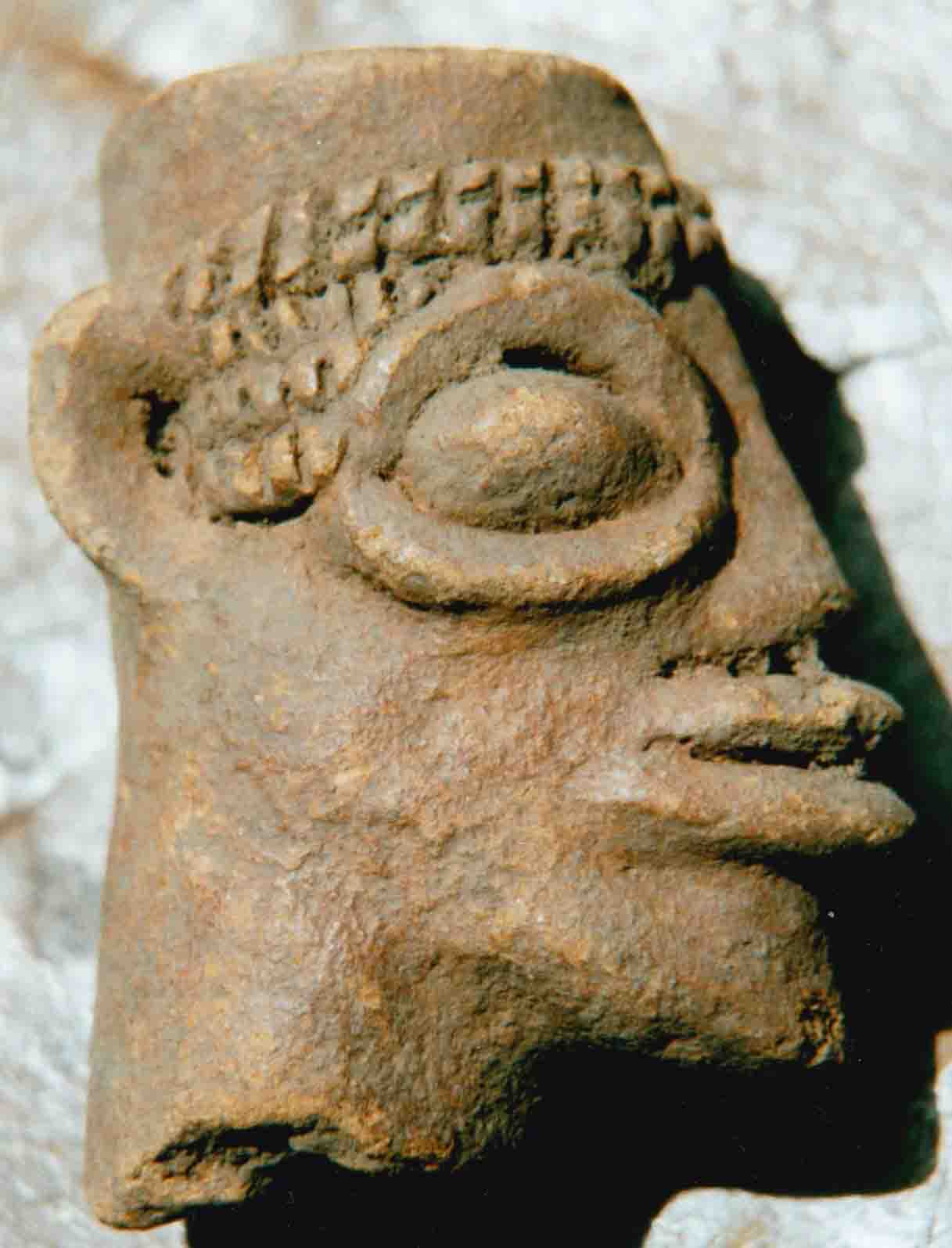 |
|
Fig. 56 |
One of the typical characteristics of Komaland figurines is a band on the forehead or surrounding the whole upper head (Fig. 56-58; Fig. 17, Fig. 32, Fig. 68). A complete and convincing identification of this characteristic with real-world (i.e. non-ceramic) counterparts is still pending. Are these bands a part of the hairstyle? Do they consist of fibres, leather, cloth, etc.? Or do they represent the brims of caps? Cocle (1991, p. 146, no 9) calls them diadems (...boven de ogen een soort diadeem), which means that he regards them as symbols of rank, dignity and authority. In the Guide (p. 29, bottom right) the phenomenon is interpreted as being part of a cap (...wearing a cap with a brim). I am more inclined to regard it as being made up of hair because the incised patterns often resemble those found on beards. Moreover, the band sometimes does not surround the whole head, as is expected of diadems and caps, but falls down in front of the ears (Fig. 57).
|
|
|
Fig. 57 - 61. Hairstyles |
10 The Discovery
Accounts of new excavations usually start with a short section on the first discovery of the artefacts. Some personal reasons have inclined this reviewer (F. Kröger), who is involved in the discussion of the discovery, to publish this chapter at the end of his review.
Archaeologists from the University of Ghana (Legon) have given various accounts of the discovery and the discoverers of the Komaland terracottas, which, for an outsider, may sound a little confusing and contradictory.
In Anquandah’s and van Ham’s early publication from 1985, van Ham is declared the discoverer (p. 28), though Ben Baluri Saibu and Franz Kröger are also mentioned. The statement that van Ham was the discoverer is flawed since having been "shown some of the terracotta sculptures by art traders in Ouagadougou and Kumasi" (p. 7) does not justify this title.
In his 1998 book, Anquandah gives a detailed description of the discovery in a chapter titled "Discovery by German scholars" (p. 16). Kröger is mentioned, having notified the Department of Archaeology (Legon) of the discoveries. I agree with Anquandah’s account except for his use of the plural "scholars" in the headline, for no other anthropologists from the University of Münster had a share in the discovery.
The main placard from the Komaland exhibition at the Ghana National Museum (Accra) describes the discovery without mentioning any names: "In 1984 a German anthropologist discovered ancient mounds around Yikpabongo...". The discovery of "mounds" misses the point since the "German anthropologist" did not see any mounds but instead was only interested in the terracottas stored in Yikpabongo’s compounds.
In his 1985 booklet (p. 7), Anquandah also mentions Ben Baluri Saibu and his contribution to the discovery: "Other hints came to the national museum from Ben Baluri Saibu...a native of Yikpabongo". In his 1998 publication, Anquandah points out: "Saibu selected and presented a number of sculptures to the Ghana Museums and Monuments Board at Accra urging that the Koma sites be subjected to scientific investigations". A date for Saibu’s notification is not given in either of the two publications. In fact, we can only find the mention of a date in Kankpeyeng’s 2004 paper (p. 102): "These... figurines were initially reported to the curators and Director of the National Museum in 1982 by Ben Baluri Saibu..." This means that Saibu reported his finds two years before Kröger in the year of the first publication on Komaland terracottas, but his notifications to the museum did not result in any excavations. When Kröger visited the Department of Archaeology in May 1984, Professor Anquandah, who was considered the most suitable Ghanaian archaeologist to carry out excavations in Komaland, did not know anything about the terracottas and he started his investigations there a few months later.
In the Manchester exhibition’s Guide, we find the following remarks on the discovery (p. 5)
...[the figurines] were discovered following reports by villagers of finding figurines, called Kronkronbua or ‘Olden Days Children’ [correctly ‘Child’] in the local Koma language. The anthropologist Franz Kröger heard about the discoveries and told Professor Anquandah about them.
This quotation demands some discussion about what should be meant by "discovery". Is a discoverer the person who happens to hit upon some artefacts without recognizing their historical or artistic significance, or is the discoverer the one who initiates scientific research and causes archaeological excavations? If only the first of the alternatives is accepted, the history of West African archaeology must be rewritten, and the discoverer of the Nok-terracottas would not be Bernhard Fagg, but the miner who first found a figure among the waste and alluvial deposits of the Nigerian tin mines (cf. B. Fagg 1977, p. 11-13).
It is not quite sufficient to write that Kröger simply heard about and reported these "discoveries". His contribution to the scientific discovery and his initiating archaeological research of the Komaland figurine might have been pointed out. His claim is based on the following three activities:
• After being shown two terracotta heads in a pile of stones in Wiaga-Zamsa (Bulsaland) on September 1st, 1978, he launched the first publication about "Komaland terracottas" in 1982, although in the publication’s text and pictures they were not named as such.
• On May 3rd, 1984, he arranged the first dating of a terracotta figurine at the Max Planck Institute for Nuclear Physics at Heidelberg (cf. Anquandah 1985, p. 31). The thermoluminescence (TL) analysis yielded an age of 405 + 135 years, which, for the first time, proved that these figurines had not been created in recent times and were thus of considerable historical significance.
• After visiting Yikpabongo, he informed Professer James Anquandah, Head of the Department of Archaeology (Legon) on July 16th, 1984, about the finds and the TL-analysis. By March of 1985, his information resulted in the first excavations in Yikpabongo.
11 Concurring Interpretations
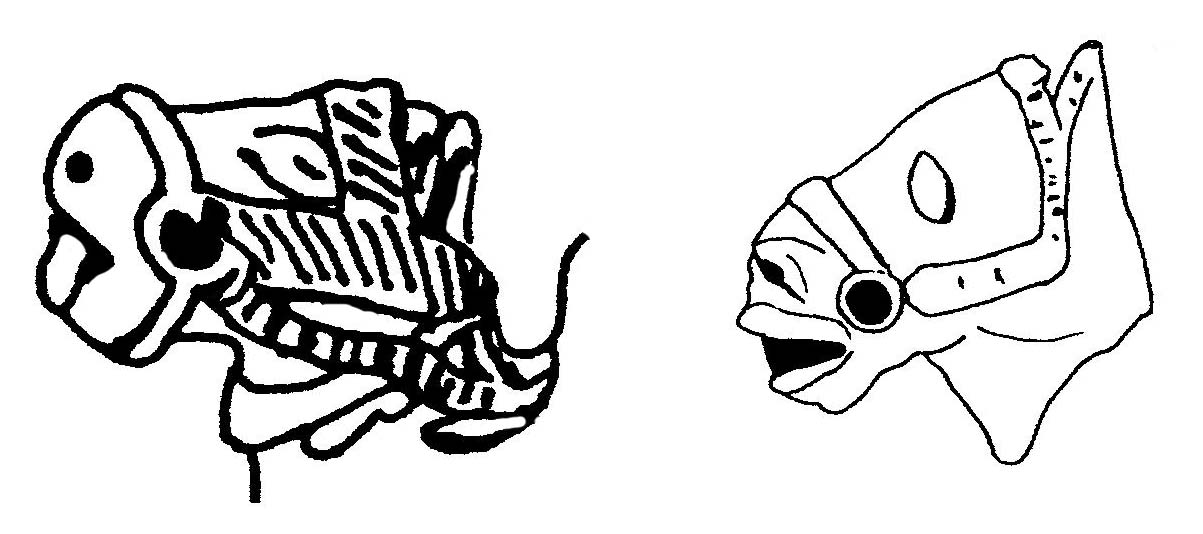 |
|
Fig. 62-63. Iron rings as part of the harness |
Although the authors of the Guide and this reviewer disagree in some details of the interpretations, they do concur in several of their explanations of phenomena associated with the terracottas.
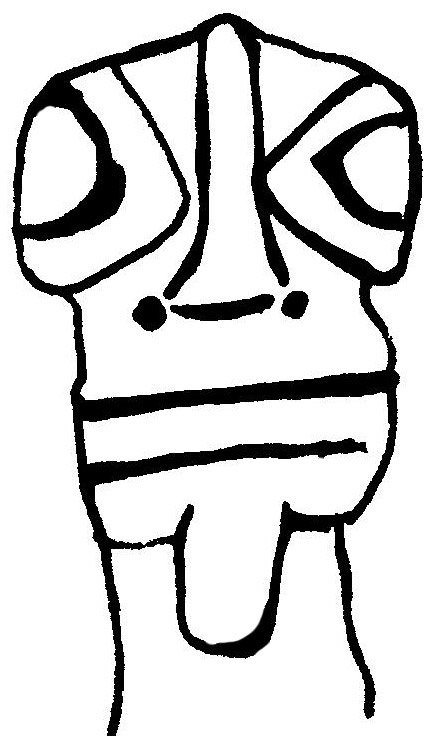 |
Fig 64. A lip plug? |
• Some iron rings excavated by the authors were probably, as pointed out on page 35, too small to be bracelets but might well have been used for the harnesses for horses as it can be proved by several representations of terracotta horses (Fig. 62-63). Bangles were also worn by babies as the mother-and-child representations demonstrate, but the exhibited rings would still be too small and would not correspond to the typical form of a bangle.
• On p. 33 (bottom right) the photo of a quartz disk is interpreted as a lip or ear plug. Although hitherto I have only seen elongated lip plugs, e.g. among the Tamberma of Togo and perhaps also in one Komaland figurine (Fig. 64), these round plugs certainly existed in the past. Rattray (1932, after p. 446, Fig. 114) published a photo of a Lobi woman with a round plug over the upper lip and another one under the lower lip, both of them resembling the one depicted in the Guide.
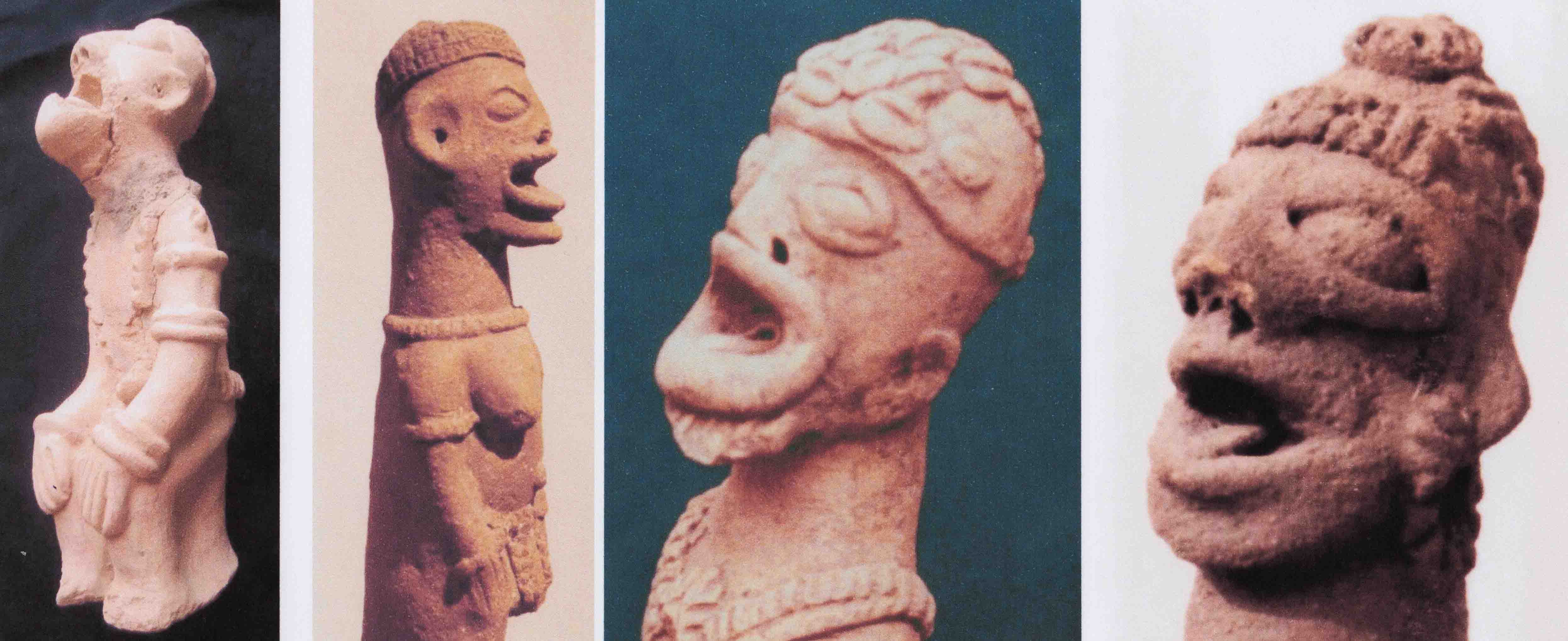 |
|
Fig. 65 - 68. Figurines with open mouths. |
• The hollow bowl-like indentation on the skull (with a “tongue” and a deep hole) and the wide open mouth (with a “tongue” and a deep hole in the throat), have resulted in different explanations by experts. According to Anquandah (1998, p. 164) the open mouths
“may refer to one of four possible behaviours associated with funeral activities, namely. Praise chants... in honour of deceased statesmen and celebrities... general singing of dirges at funerals... general wailing... and war cries or shouts uttered to usher brave warrior to their graves...
These interpretations scarcely hold true for the open mouths of animals (Fig. 69) and ceramic janiform discs (Fig. 70), which usually have the same characteristics (i.e. the tongue and the deep hole).
In 1988 (p. 133 and 135) I tried to explain these two phenomena as receptacles for receiving sacrifices, and my further research has substantiated this assumption. In the Guide this interpretation has been adopted, although sometimes with a certain restriction, or the authors have come to similar results independently.
p. 21 (right middle): ... perhaps allowing libations to be offered.
p. 23 (right): Occasionally incised, perhaps for libations...
p. 29 (top): ...open mouths, perhaps representing speech or sound or to receive something.
p. 32 (top left): ...the expressive open mouths might depict pain, sorrow, ritual or other speech, or be for receiving libations.
p. 32 (right) ...mouths as if imploring or receiving something.
In spite of all the attempts of the authors of the Guide and this reviewer to find conclusive interpretations, the mystery surrounding the meaning of the Komaland terracotta figures as a whole as well as the meaning of particular elements adorning their bodies remains – perhaps even for eternity.
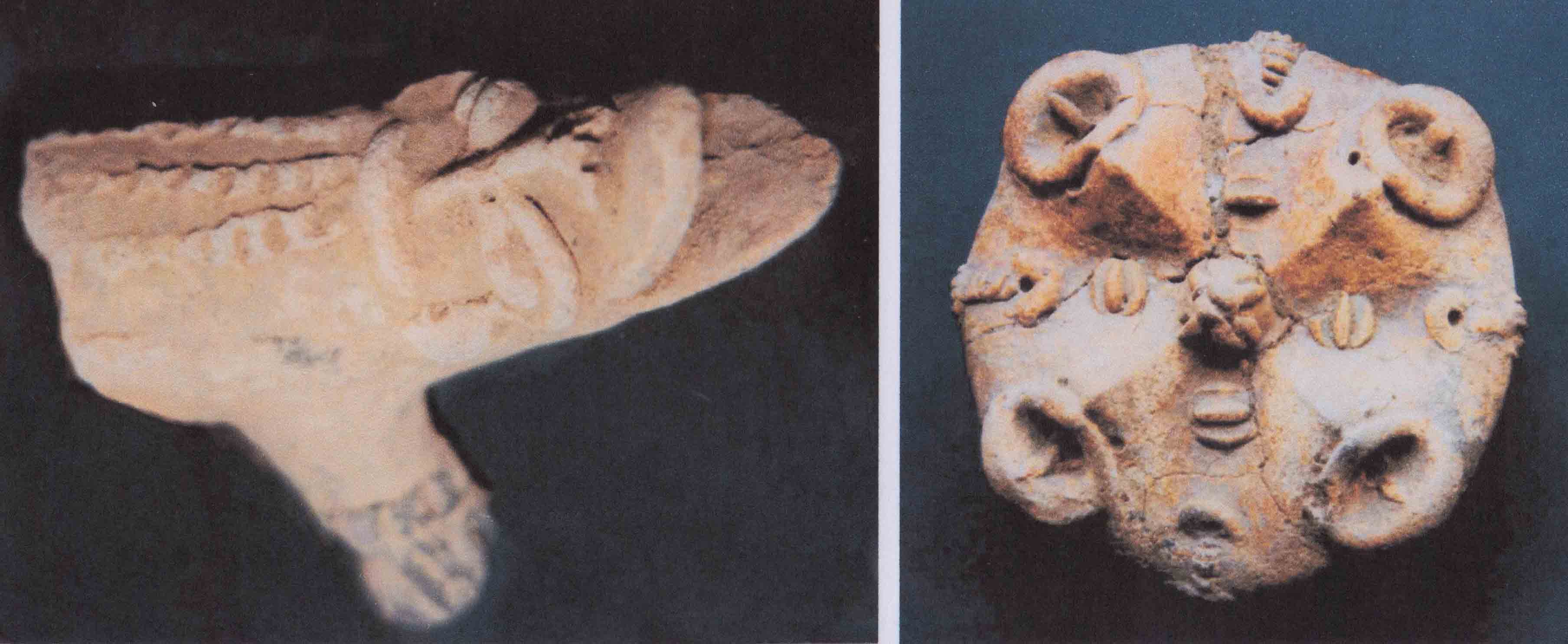 Fig. 69. Crocodile with open mouth. Fig. 70. Janiform ceramic disc with four open mouths |
REFERENCES
Anquandah, James and Laurent van Ham (1985)
Discovering the forgotten "civilization" of Komaland, Northern Ghana. Rotterdam.
Anquandah, James (1986)
Investigating the stone circle mound sites and art works of Komaland, northern Ghana. Nyame Akuma 27, pp. 10-13.
Anquandah, James (1987)
The stone circle sites of Komaland, Northern Ghana, in West African archaeology. In: The African Archaeological Review, 5, pp. 171-180.
Anquandah, James (1998)
Koma - Bulsa. Its Art and Archaeology. Istituto italiano per l'Africa e l'oriente Roma [Review: see Kröger, Franz, 2002].
Cocle, Jan (1991)
Terracotta in West-Afrika. In: A. Maesen, M.G. Mudiji, A.K.H. Abasi, V. Neckerbrouck, A.P. Bourgeois, J. Cocle, M. Sabbe, F. Gistelinck (eds.): Kronkronbali, figuratieve terracotta uit West-Afrika met cadensen van José Vermeersch. Leuven: Bibliotheek van de Faculteit der Godgeleerdheid.
Fagg, Bernard (1977)
Nok terracottas. Lagos: Ethnographica for the National Museum.
Frehn, Beatrice and Krings, Thomas (1986)
Afrikanische Frisuren. Symbolik und Formenvielfalt traditioneller und moderner Haartrachten im westafrikanischen Sahel und Sudan. Köln: Dumont.
Goody, Jack (1962)
Death, Property and the Ancestors. A Study of Mortuary Customs of the LoDaaga of West Africa. London: Tavistock Publications.
Insoll, Timothy Benjamin Kankpeyeng, Samuel N. Nkumbaan and Malik Saako (2013)
Fragmentary Ancestors. Figurines from Koma Land, Ghana. Manchester (Museum).
Junkelmann, Marcus (1992)
Die Reiterei Roms. Teil III: Zubehör, Reitweise, Bewaffnung. Mainz: Philipp von Zabern.
Kankpeyeng, Benjamin W. and Christopher R. DeCorse (2004)
Ghana’s Vanishing Past: Development, Antiquities and the Destruction of the Archaeological Record. African Archaeological Review, vol 21, no. 2, pp. 89-129.
Kankpeyeng, Benjamin W. and Samuel Nkumbaan (2008)
Rethinking the Stone Circles of Komaland. A Preliminary Report on 2007/2008 Fieldwork at Yikpabongo, Northern Region, Ghana. In: Insoll T. (ed.): Current Archaeological Research in Ghana. Cambridge Monographs in African Archaeology 74. Oxford: Archaeopress, pp. 95-102.
Kröger, Franz (1982)
Ancestor worship among the Bulsa of Northern Ghana. Religious, social and economic aspects. Kulturanthropologische Studien, vol. 9, Hohenschäftlarn [pp. 16-20 and plates 16-17: “Komaland” terracottas].
Kröger, Franz (1988)
Die Terrakotta-Funde des Koma-Gebietes (Nordghana). In: Paideuma 34, pp. 129-142.
Kröger, Franz (2001)
Materielle Kultur und traditionelles Handwerk bei den Bulsa (Nordghana). Forschungen zu Sprachen und Kulturen Afrikas (ed. R. Schott), 2 vols, Münster and Hamburg: Lit-Verlag.
Kröger, Franz (2002)
Review on J. Anquandah, Koma - Bulsa. Its Art and Archaeology (1998), Arts d'Afrique Noire, no. 124, p. 55.
Kröger, Franz and Ben Baluri Saibu (2010)
First Notes on Koma Culture. Life in a Remote Area of Northern Ghana. Münster, Berlin: Lit-Verlag. Brunswick, New York: Transaction Publishers.
Lagercrantz, Sture (1937)
Ringdolche, Armdolche und Schlagringe in Afrika. In: Zeitschrift für Ethnologie 69, pp. 389-443.
Lagercrantz, Sture (1950)
Contribution to the Ethnography of Africa [pp. 206-214: arm-daggers].
Lund: Studia Ethnographica Upsaliensa I.
Law, Robin (1980)
The Horse in West African History: The Role of the Horse in the Societies of Pre-colonial West Africa. London: Oxford University Press.
Meyer, Piet (1981)
Kunst und Religion der Lobi. Zürich: Museum Rietberg.
Rattray, Robert S. (1932)
The Tribes of the Ashanti Hinterland. 2 vols., Oxford: Clarendon Press.